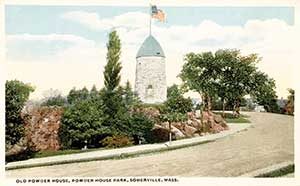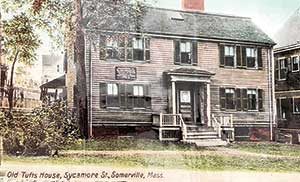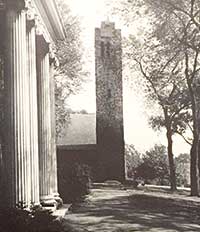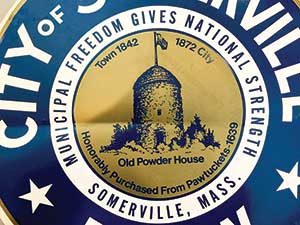
Eagle Feathers #192 – The Tufts Family
By Bob (Monty) Doherty
The oldest stone building in Massachusetts still stands proudly in the center of Somerville’s Quarry Hill. Referred to as, The Powder House, this structure has stood its ground for over 315 years. Originally built as a gristmill in 1704, it was sold in 1747 to the Massachusetts Bay Colony for use as a gunpowder magazine.
Its day in the sun was on September 1, 1774, when British soldiers raided it and its 240 barrels of powder were captured and brought to Boston. By the next day, thousands of armed militiamen had rushed to this area. Cooler heads prevailed and war was averted for the next eight months. The Powder House incident was the dress rehearsal for the battles of Lexington, Concord and Bunker Hill.

In 1818, the state sold the Powder House to Peter Tufts, a member of the Tufts family. This family has been part of Somerville’s fabric going back to before the Revolutionary War. The Powder House and its land were then passed on in 1836 to brickyard owner Nathan Tufts and his heirs who in 1890 donated it to the city and named it after him.
Throughout Somerville’s history, members of the Tufts family have made an enduring image on our city. Let’s begin with the Revolution.
-
-
- The family of Timothy Tufts was witness to the early British march toward Lexington and skirmish at Elm Street on their retreat to Charlestown.
- Anne Adams Tufts nursed many wounded Bunker Hill soldiers at her Winter Hill home.
- During the Siege of Boston from 1775 to 1776, Oliver Tufts’ house on Somerville Avenue became the headquarters for Washington’s General Nathanael Greene. Samuel Tufts house on Sycamore Avenue, today’s oldest house in Somerville, became the Headquarters of General Charles Lee.

-
- In 1804, Samuel Tufts donated land to establish the Milk Row Cemetery on today’s Washington Street.
- In 1851, printer Edmund Tufts who was the town’s first Treasurer and Collector had an office on Winter Hill. He created Somerville’s first directory that contained the names of the heads of families, their occupations, and dwellings. Members of the Tufts family owned fourteen of these households.

-
-
- In 1850, a Board of Engineers had been appointed in Somerville to supersede the old Board of Fire Wards and Nathan Tufts, Jr. was appointed as its first fire chief. In this position, he commanded fifty volunteer firefighters.

- In 1852, Charles Tufts donated 100 acres of land to establish a college across from the Powder House. He told a friend, “I will put a light upon that hill.” Today, that light is Tufts University.
- Sarah Miller Tufts, wife of Nathan Tufts, brought one of Somerville’s heroic families into the Tufts fold through her relation to Somerville’s Revolutionary martyr, James Miller, and his grandson Charles who originated Somerville’s name.
-

- In 1872, the prior home of Nathan Tufts, Jr. at One Arlington Street was later the terminus of the world’s first outside telephone call.
- Nathan Tufts died in 1872, the year Somerville became a city. That year a municipal seal depicting General Washington on Prospect Hill was selected. It lasted one hundred years, until 1972 when it was changed to today’s Powder House.

At one time, Tufts relatives owned one tenth of the of the city’s land. Party gatherings on Winter Hill were said to attract 60 to 70 family members. The Powder House, its Park, and “the Light Upon The Hill” owe their existence to this historic and generous family.
-















Reader Comments